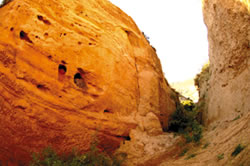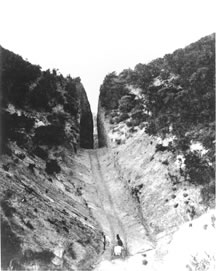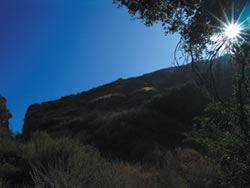FAMILY - FAMILY FEATURES
Beale's Cut
Passage to the World
August, 2005 - Issue #10
 Beale’s Cut today |
With the discovery of oil in Pico Canyon, the area "boomed" in population to hundreds of permanent residents. Thousands more residents followed in the oil boom in Kern County around Baker's Field. Prior to the early 1860s, the only passable route from the basin into the northern stretches of Los Angeles County and up into the Central Valley was over the San Fernando Mountains. The grade was very steep and the terrain very unstable. Rains frequently washed out the few trails. Numerous times the Los Angeles Board of Supervisors commissioned Army and private contractors to improve the road so that constant communication, mail, and supplies could be more assured. Each time the projects failed and the problems continued.
It was not until 1862 that General Edward F. Beale, then Surveyor General for California-Nevada, dug a 90-foot pass through the mountains with nothing more than picks and shovels. This marvel of engineering was finally completed on March 5, 1864 and lasted for more than 80 years without a slide or closure.
 Beale’s Cut was forged manually with hard larbor and pick axes |
President Andrew Jackson granted Beale admittance to the Naval School (Naval Academy) where he graduated in 1842. Following a brief command on the USS Congress in 1846, Beale had his first experience in land combat in the Mexican American War. The besieged American forces were rescued at San Pasqual, when Beale escaped through the enemy lines and brought troops from San Diego. In the following years, Beale was placed in charge of Indian Affairs in California and Nevada and later participated in a test for the United States Army using camels. (Though Beale reported they faired well as pack animals they spooked the horses and mules and the idea was abandoned.)
With the outbreak of the Civil War, Beale sought a commission in the Army but was convinced by President Lincoln to remain Surveyor General of California and keep the western half of the Union intact. It was during this time as Surveyor General that Beale commissioned and commanded the construction of the passage through the San Fernando Mountains, now called Beale's Cut. After the war, Beale owned and managed the 270,000-acre Tejon Ranch. He was proposed for the post of Secretary of the Navy but was passed over by President Cleveland. During his last years he lived at both the Ranch and the Decatur House, then one of the most elite addresses in the nation, until his death in 1893.
 |
History is all around us. The Santa Clarita Valley is full of historical treasures and interesting stories. For more about Beale's Cut or any other facets of Santa Clarita history, visit the Santa Clarita Valley Historical Society at Heritage Junction inside of Hart Park or visit them online at www.scvhistory.com.
|
||||||||||||||||||||||||||||




